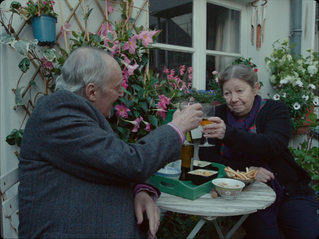The Velvet Vampire
- Charlotte Mansfield
- Jan 2, 2021
- 3 min read
Updated: Feb 2, 2021
Stephanie Rothman, 1971

Cult horror The Velvet Vampire follows couple Lee and Susan to the desert, where they plan to stay with the mysterious Diane, unaware that she is a vampire intending to seduce them, and feast. The highly explored sexuality and lust of vampires is reassigned to a woman, changing the dynamics of the traditional Dracula-esque tale. This along with the sumptuous landscape, enjoyable performances and obvious innuendo renders Stephanie Rothman’s picture an under-appreciated prototype of horrors that redefine gender roles, precursing camp classic The Rocky Horror Picture Show and late 2000s flop-to-favourite Jennifer’s Body.


It is possible to overlook some lack of continuity in the film, such as when Diane happily walks outside without her driving gloves despite her vampiric weakness to the sun, due to the film’s absurdity. There is a strange, comical abruptness in the dialogue and events which contradict what characters want; after being invited to Diane’s isolated home and deciding to “forget the whole thing and stay home” the next sequence shows the couple on their way. The film frames interesting silent punchlines such as this, which are not further addressed, revealing its rather sophisticated sense of self-awareness despite the outrageous events.

Another way this is executed is through the delightful costume design by Keith Hodges. Diane’s style plays up to her animalistic side: she openly asserts “why fight the animal in you?”. Perhaps the most iconic piece in the film is her extravagant flamingo-pink feather-trim nightgown, which she wears in pursuit of Lee’s seduction. This is in contrast to Susan’s sleep attire: a white fluffy babydoll. Though her clothing highlights her feminine features, Susan resembles purity next to Diane. Her soft blonde hair is in opposition to the vampire’s which is almost black; her colour palette at the start of the film is more grounded in earth tones, and, as a married woman, her choices appear to be for her own pleasure rather than for any ulterior motives. The initial meeting of the women may be the most obvious example of the angel-devil dynamic, with Diane in blood red, her dress hugging her figure and the white ruffle collar encircling her cleavage, while Susan wears a high-neck green top, comfortably stylish and friendly.

Despite their differences, the two women also mimic each other’s fashion choices throughout the film. After catching Diane and Lee making love on top of the pink feather gown, Susan wears a hot pink halter-neck mini dress the following morning, as if trying to emulate the vampire’s sex appeal. Rather than confronting Lee, Susan appears far too relaxed about the infidelity and instead continues to bathe herself in sunlight and sartorially joust with Diane. Later, she dons an orange bikini to mirror Diane’s head-to-toe monochromatic look (which even matches her armchair), before Diane appears outside in a flesh-coloured suit to match Susan’s bare skin. It appears that after meeting with conflicting tastes, the women slowly become more like each other — a testament to Diane’s manipulation of not only the couple, but of a woman she desires both sexually and as a meal. This brings to mind the infamous aphorism “don’t play with your food”, one which Diane clearly ignores and suffers as a result. The stylishness runs to the very end, Diane’s demise sees her fall to the ground in an open keyhole blouse —even in death she looks chic and sensual— while Susan’s men’s khaki jacket thrown over her bikini in a hurry is the epitome of effortless cool.









Comments